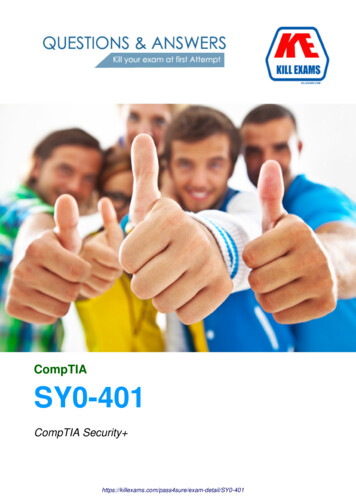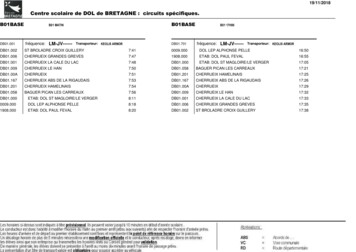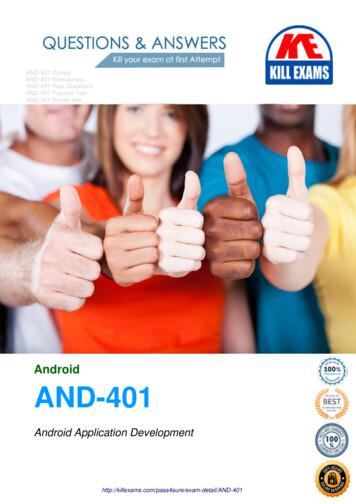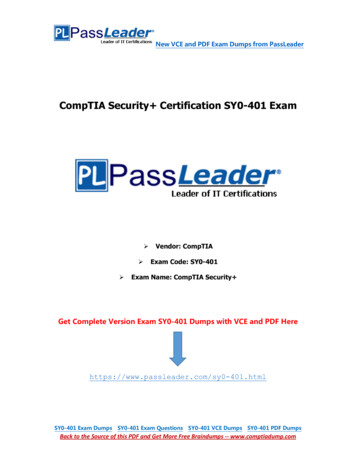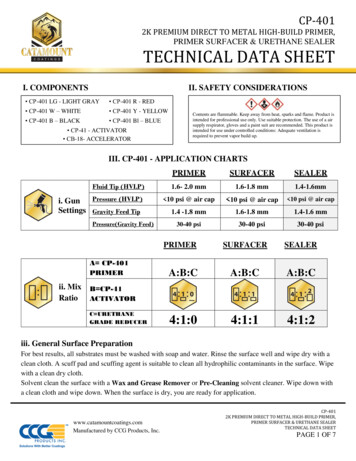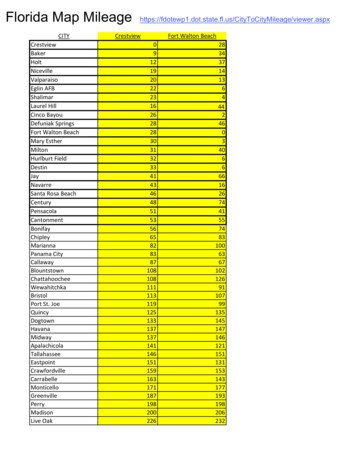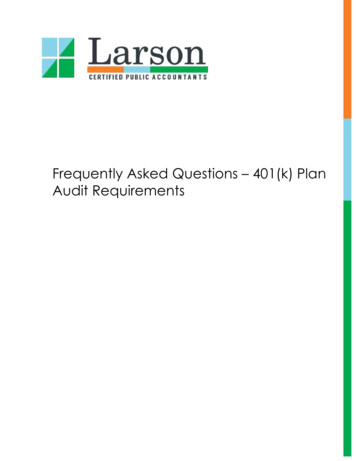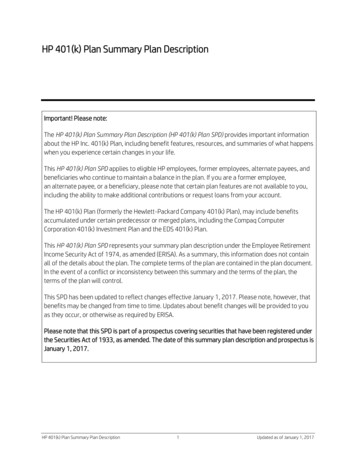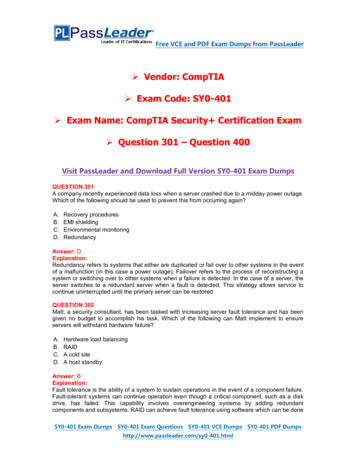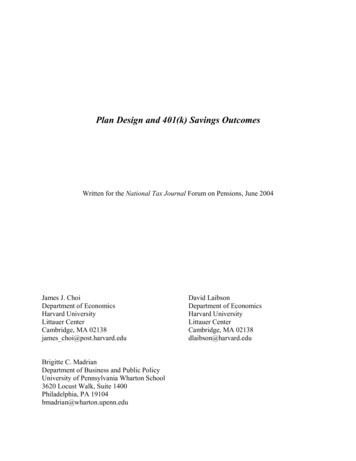
Transcription
401 (K) PLANSFOR SMALL BUSINESSES
401(k) Plans for Small Businesses is a joint project of the U.S. Department ofLabor’s Employee Benefits Security Administration (EBSA) and the InternalRevenue Service.To view this and other EBSA publications, visit the agency’s website.To order publications or speak with a benefits advisor, contact EBSAelectronically.Or call toll free: 866-444-3272This material will be made available in alternative formatto persons with disabilities upon request:Voice phone: (202) 693-8664TTY: (202) 501-3911This booklet constitutes a small entity compliance guide for purposes of the Small BusinessRegulatory Enforcement Fairness Act of 1996.
Why 401(k) Plans?401(k) plans can be a powerful tool in promoting financial security in retirement. They are avaluable option for businesses considering a retirement plan, providing benefits to employeesand their employers.A 401(k) plan:n Helps attract and keep talented employees.n Allows participants to decide how much to contribute to their accounts.n Entitles employers to a tax deduction for contributions to employees’ accounts.n Benefits a mix of rank-and-file employees and owners/managers.n Permits money contributed to grow through investments in stocks, bonds, mutual funds, moneymarket funds, savings accounts, and other investment vehicles.n Offers significant tax advantages (including deduction of employer contributions and deferredtaxation on contributions and earnings until distribution).n Allows participants to take their benefits with them when they leave the company, easingadministrative responsibilities.This publication provides an overview of 401(k) plans. For more information, resources for both youand your employees are listed at the end of this booklet.401(K) PLANS FOR SMALL BUSINESSES1
Establishing a 401(k) PlanWhen you establish a 401(k) plan, you must take certain basic actions. One of your first decisions willbe whether to set up the plan yourself or to consult a professional or financial institution – such as abank, mutual fund provider, or insurance company – to help you establish and maintain the plan. Inaddition, there are four initial steps for setting up a 401(k) plan:n Adopt a written plan document,n Arrange a trust for the plan’s assets,n Develop a recordkeeping system, andn Provide plan information to employees eligible to participate.Adopt a written plan document – Plans begin with a written document that serves as the foundationfor day-to-day plan operations. If you hired someone to help with your plan, that person likely willprovide the document. If not, consider getting assistance from a financial institution or retirement planprofessional. In either case, you will be bound by the terms of the plan document.Once you have decided on a 401(k) plan, you will need to choose the type of plan best for you – atraditional 401(k) plan, a safe harbor 401(k) plan, or an automatic enrollment 401(k) plan. In all theplans described below, participants can contribute through salary deductions.A traditional 401(k) plan offers the most flexibility. Employers can decide whether to contribute forall participants, to match employees’ deferrals, to do both, or to do neither. These contributions can besubject to a vesting schedule that provides that an employee’s right to employer contributions becomesnonforfeitable only after a certain amount of time. Annual testing ensures that benefits for rank-andfile employees are proportional to benefits for owners/managers.Several kinds of 401(k) plans are not subject to the annual contributions testing that traditional 401(k)plans require. These are known as safe harbor 401(k) plans and, in exchange for avoiding annualtesting, employees in these plans must receive a certain level of employer contributions. Under themost popular safe harbor 401(k) plan, mandatory employer contributions must fully vest when made.An automatic enrollment 401(k) plan allows you to automatically enroll employees and place theirsalary deductions in certain default investments, unless the employee elects otherwise. This is aneffective way for employers to increase participation in their 401(k) plans.The traditional, safe harbor, and automatic enrollment plans are for employers of any size.This booklet addresses traditional and safe harbor 401(k) plans. For more information on automaticenrollment 401(k) plans, see Automatic Enrollment 401(k) Plans for Small Businesses (Publication 4674).Once you have decided on the type of plan for your company, you have flexibility in choosing some ofthe plan’s features, such as which employees can contribute to the plan and how much. Other featureswritten into the plan are required by law. For instance, the plan document must describe how certainkey functions are carried out, such as how contributions are deposited in the plan.2U.S. DEPARTMENT OF LABOR
Arrange a trust for the plan’s assets — A plan’sassets must be held in trust to assure that the assetsare used solely to benefit the participants and theirbeneficiaries. The trust must have at least onetrustee to handle contributions, plan investments,and distributions. Since the financial integrity of theplan depends on the trustee, selecting a trustee isone of the most important decisions you will makein establishing a 401(k) plan. If you set up yourplan through insurance contracts, the contracts donot need to be held in trust.Develop a recordkeeping system — Anaccuraterecordkeeping system will track and properlyattribute contributions, earnings and losses, planinvestments, expenses, and benefit distributions.If a contract administrator or financial institutionassists in managing the plan, that entity typicallywill help keep the required records. In addition,a recordkeeping system will help you, your planadministrator, or your financial provider preparethe plan’s annual return/report that must be filedwith the Federal Government.Provide plan information to employees eligibleto participate — You must notify employeeswho are eligible to participate in the plan aboutcertain benefits, rights, and features. In addition, asummary plan description (SPD) must be provided to all participants. The SPD is the primary vehicleto inform participants and beneficiaries about the plan and how it operates. It typically is created withthe plan document. (For more information on the required contents of the SPD, see Disclosing PlanInformation to Participants.)You also may want to provide your employees with information that discusses the advantages of your401(k) plan. The benefits to employees – such as pretax contributions to a 401(k) plan (or tax-freedistributions in the case of Roth contributions), employer contributions (if you choose to make them),and compounded tax-deferred earnings – help highlight the advantages of participating in the plan.Operating a 401(k) PlanOnce you establish a 401(k) plan, you assume certain responsibilities in operating it. If you hiredsomeone to help set up your plan, that arrangement also may include help in operating the plan. Ifnot, you’ll need to decide whether to manage the plan yourself or to hire a professional or financialinstitution – such as a bank, mutual fund provider, or insurance company – to take care of some ormost aspects of operating the plan.401(K) PLANS FOR SMALL BUSINESSES3
Elements of operating 401(k) plans include:n Participationn Contributionsn Vestingn Nondiscriminationn Investing the contributionsn Fiduciary responsibilitiesn Disclosing plan information to participantsn Reporting to government agenciesn Distributing plan benefitsParticipationTypically, a plan includes a mix of rank-and-file employees and owners/managers. However, a 401(k)plan may exclude some employees if they:n Are younger than 21,n Have completed less than one year of service,n Are covered by a collective bargaining agreement, if retirement benefits were the subject ofgood faith bargaining, orn Are certain nonresident aliens.ContributionsIn all 401(k) plans, participants can contribute through salary deductions. You can decide on yourbusiness’s contribution to participants’ accounts in the plan.Traditional 401(k) PlanIf you decide to contribute to your 401(k) plan, you have further options. You can contribute apercentage of each employee’s compensation for allocation to the employee’s account (called anonelective contribution), you can match the amount your employees contribute (called a matchingcontribution), or you can do both.For example, you may decide to add a percentage – say, 50 percent – to an employee’s contribution,which results in a 50-cent increase for every dollar the employee sets aside. Using a matching4U.S. DEPARTMENT OF LABOR
contribution formula will provide employer contributions only to employees who make deferrals to the401(k) plan. If you choose to make nonelective contributions, the employer contribution goes to eacheligible participant, whether or not the participant decides to make a salary deferral to their 401(k) planaccount.Under a traditional 401(k) plan, you have the flexibility of changing the amount of employercontributions each year, according to business conditions.Safe Harbor 401(k) PlanUnder a safe harbor plan, you can match each eligible employee’s contribution, dollar for dollar, up to3 percent of the employee’s compensation, and 50 cents on the dollar for the employee’s contributionthat exceeds 3 percent, but not 5 percent, of the employee’s compensation. Alternatively, you can makea nonelective contribution equal to 3 percent of compensation to each eligible employee’s account.Each year you must make either the matching contributions or the nonelective contributions. The plandocument will specify which contributions will be made and this information must be provided toemployees before the beginning of each year.Roth Contributions401(k) plans may permit employees to make after-tax contributions through salary deduction. Thesedesignated Roth contributions, as well as gains and losses, are accounted for separately from pretaxcontributions. However, designated Roth contributions are treated the same as pretax contributions formost aspects of plan operations, such as contribution limits.A 401(k) plan may allow participants to transfer certain amounts in the plan to their designated Rothaccount in the plan.Contribution LimitsEmployer and employee contributions and forfeitures (nonvested employer contributions of terminatedparticipants) are subject to a per-employee overall annual limitation. This limit is the lesser of:n 100 percent of the employee’s compensation, orn 57,000 for 2020 and 58,000 for 2021.In addition, the amount employees can contribute under any 401(k) plan is limited to 19,500 for2020 and for 2021. This includes both pre-tax employee salary deferrals and after-tax designated Rothcontributions (if permitted under the plan).All 401(k) plans may allow catch-up contributions of 6,500 for 2020 and for 2021 for employees age50 and over.401(K) PLANS FOR SMALL BUSINESSES5
VestingEmployee salary deferrals are immediately 100 percent vested – that is, the money that an employeehas contributed to the plan cannot be forfeited. When an employee leaves employment, they areentitled to those deferrals, plus any investment gains (or minus losses) on the deferrals.In safe harbor 401(k) plans, all required employer contributions are always 100 percent vested. Intraditional 401(k) plans, you can design your plan so that employer contributions vest over time,according to a vesting schedule.NondiscriminationTo preserve the tax benefits of a 401(k) plan, the plan must provide substantive benefits forrank-and-file employees, not just business owners and managers. These requirements are callednondiscrimination rules and compare both plan participation and contributions of rank-and-fileemployees to owners/managers.Traditional 401(k) plans are subject to annual testing to ensure that the amount of contributions madefor rank-and-file employees is proportional to contributions made for owners and managers. In mostcases, safe harbor 401(k) plans are not subject to annual nondiscrimination testing.Investing the ContributionsAfter you decide on the type of 401(k) plan, you can consider the variety of investment options. Indesigning a plan, you will need to decide whether to permit your employees to direct the investmentof their accounts or to manage the monies on their behalf. If you choose the former, you must decidewhat investment options to make available to the participants. Depending on the plan design youchoose, you may want to hire someone either to determine the investment options or to manage theplan’s investments. Continually monitoring the investment options ensures that your selections remainin the best interests of your plan and its participants.Fiduciary ResponsibilitiesMany of the actions needed to operate a 401(k) plan involve fiduciary decisions. This is true whether youhire someone to manage the plan for you or do some or all of the plan management yourself. Controllingthe assets of the plan or using discretion in administering and managing the plan makes you and theentity you hire a plan fiduciary to the extent of that discretion or control. Providing investment advice fora fee also makes someone a fiduciary. Hiring someone to perform fiduciary functions is itself a fiduciaryact. Thus, fiduciary status is based on the functions performed for the plan, not a title.Some decisions for a plan are business decisions, rather than fiduciary decisions. For instance, thedecisions to establish a plan, to include certain features in a plan, to amend a plan, and to terminate aplan are business decisions. When making these decisions, you are acting on behalf of your business,not the plan, and therefore, you would not be a fiduciary. However, when you take steps to implementthese decisions, you (or those you hire) are acting on behalf of the plan and, in carrying out theseactions, may be a fiduciary.6U.S. DEPARTMENT OF LABOR
Basic ResponsibilitiesFiduciaries are in a position of trust with respect to the participants and beneficiaries in the plan. Thefiduciary’s responsibilities include:n Acting solely in the interest of the participants and their beneficiaries;n Acting for the exclusive purpose of providing benefits to workers participating in the plan andtheir beneficiaries, and defraying reasonable plan expenses;n Carrying out duties with the care, skill, prudence, and diligence of a prudent person familiarwith such matters;n Following the plan documents; andn Diversifying plan investments.These are the responsibilities that fiduciaries need to keep in mind as they carry out their duties. Theresponsibility to be prudent covers a wide range of functions needed to operate a plan. Since all thesefunctions must be carried out in the same manner as a prudent person would, you may want to consultexperts in investments, accounting and other fields, as appropriate.In addition, for some functions, there are specific rules that help guide the fiduciary. For example, thedeductions from employees’ paychecks for contribution to the plan must be deposited with the plan assoon as reasonably possible, but no later than the 15th business day of the month following the payday.If you can reasonably make the deposits in a shorter time frame, you must do so.For plans with fewer than 100 participants, salary reduction contributions deposited with the plan nolater than the 7th business day following withholding by the employer will be considered contributedin compliance with the law.For all contributions, employee and employer (if any), the plan must designate a fiduciary, typicallythe trustee, to make sure that contributions due to the plan are transmitted. If the plan and otherdocuments are silent or ambiguous, the trustee generally has this responsibility. In addition, you (orthose you hire) will need to update the plan document for changes in the law.Limiting LiabilityWith these responsibilities, there is also some potential liability. However, you can take actions todemonstrate that you carried out your responsibilities properly and to limit your liability.The fiduciary responsibilities cover the process used to carry out the plan functions rather than simplythe results. For example, if you or someone you hire makes the investment decisions for the plan, aninvestment does not have to be a “winner” if it was part of a prudent overall diversified investmentportfolio for the plan. Since a fiduciary needs to carry out activities through a prudent process, youshould document the decision-making process to demonstrate the rationale behind the decision at thetime it was made.In addition to the steps above, there are other ways to limit potential liability. The plan can be set up togive participants control of investments in their accounts. For participants to have control, they musthave sufficient information on the specifics of their investment options. If properly executed, this type401(K) PLANS FOR SMALL BUSINESSES7
of plan limits your liability for participants’ investment decisions. You can also hire a service provideror providers to handle some or most of the fiduciary functions, setting up the agreement so that theperson or entity then assumes liability.Hiring a Service ProviderEven if you do hire a financial institution or retirement plan professional to manage the plan, youretain some fiduciary responsibility for the decision to select and keep that person or entity as theplan’s service provider. Thus, you should document your selection process and monitor the servicesprovided to determine if you need to make a change.For a service contract or arrangement to be reasonable, service providers must give you certaininformation about the services they will provide to your plan and all of the compensation they willreceive. This information will assist you in understanding the services, assessing the reasonableness ofthe compensation (direct and indirect), and determining any conflicts of interest that may impact theservice provider’s performance.Some additional items to consider in selecting a plan service provider:n Information about the firm itself:plans, and assets under its control;affiliations, financial condition, experience with 401(k)n A description of business practices: how plan assets will be invested if the firm will manageplan investments or how participant investment directions will be handled; andn Information about the quality of prospective providers:the identity, experience, andqualifications of the professionals who will be handling the plan’s account; any recent litigationor enforcement action that has been taken against the firm; the firm’s experience or performancerecord; if the firm plans to work with any of its affiliates in handling the plan’s account; andwhether the firm has fiduciary liability insurance.Once hired, you should continue to monitor your service provider by doing the following:n Evaluate any notices the service provider furnishes about possible changes to theircompensation and the other information they provided when hired (or when the contract orarrangement was renewed);n Review the service provider’s performance;n Read any reports they provide;n Check actual fees charged;n Ask about policies and practices (such as trading, investment turnover, and proxy voting); andn Follow up on participant complaints.For more information, see Understanding Retirement Plan Fees and Expenses.8U.S. DEPARTMENT OF LABOR
Providing Information in Participant-Directed PlansWhen plans allow participants to direct their investments, fiduciaries need to take steps regularly tomake participants aware of their rights and responsibilities related to directing their investments. Thisincludes providing plan- and investment-related information, including information about fees andexpenses that participants need to make informed decisions about the management of their individualaccounts. You (or those you hire) must provide that information to participants befo
Once you have decided on a 401(k) plan, you will need to choose the type of plan best for you - a traditional 401(k) plan, a safe harbor 401(k) plan, or an automatic enrollment 401(k) plan. In all the plans described below, participants can contribute through salary deductions. A . traditional 401(k) plan . offers the most flexibility.
